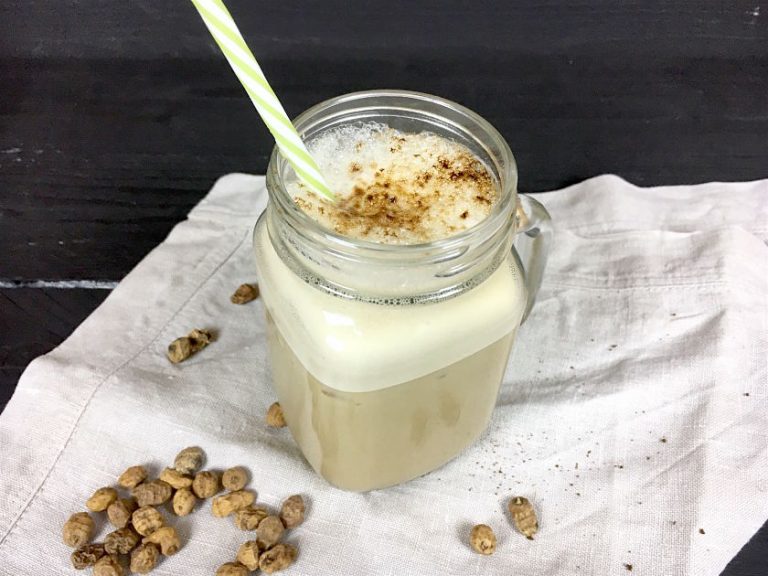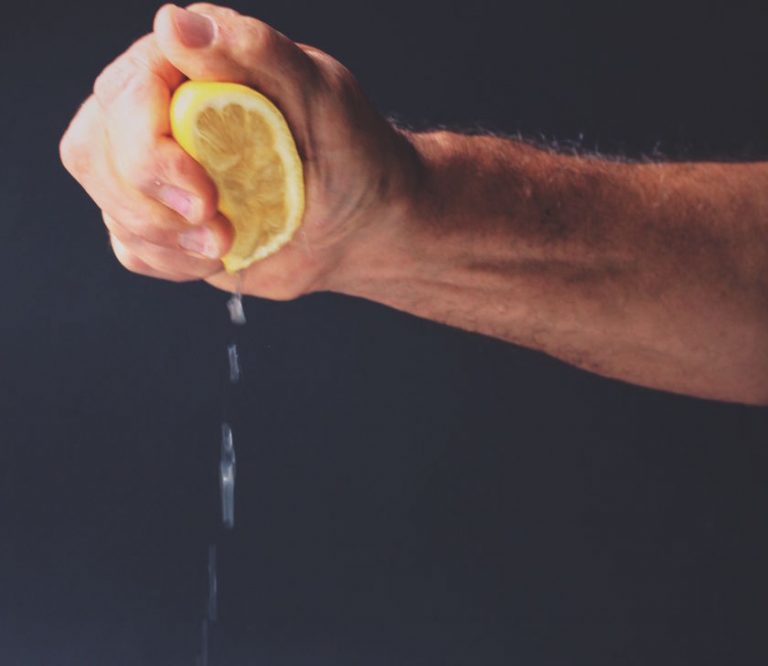Rest and nutrition during sports injuries make a difference.
Sports injuries usually consist of 2 phases, a first healing phase and a second rehabilitation phase.
1. Nutrition during injuries: Healing phase
Within the healing phase, there are three processes: inflammation, proliferation and remodeling.
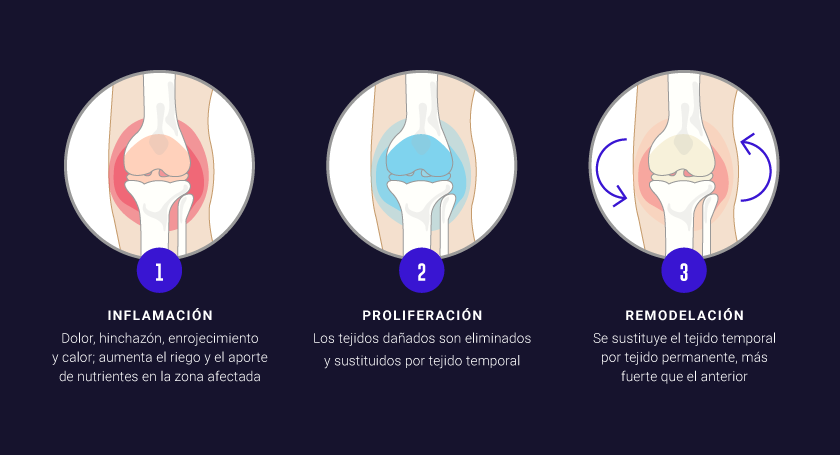
Inflammation is necessary
A very common and common mistake when we injure ourselves is to stop inflammation with ice or anti-inflammatories. Not the best idea. Inflammation is necessary because it allows all the nutrients and substances necessary for its healing to reach the damaged tissue.
But excessive inflammation can also be counterproductive for healing, therefore, foods that contain a normal amount of anti-inflammatory substances, help control inflammation without reducing it excessively, favoring healing.
For example, omega 3 reduces inflammation and helps recovery in normal doses, when it comes from foods rich in this nutrient such as avocado, flax seeds (better ground) and blue fish.
However, the important thing for the inflammatory state is not how much omega 3, but the l ratio omega 3 / omega 6. Therefore, omega 3 supplements make recovery difficult because the dose they contain is excessive . In certain cases, by reducing the supply of omega 6 fatty acids (which are mainly found in refined seed oil) we can improve general inflammation more than by increasing the supply of omega 3.
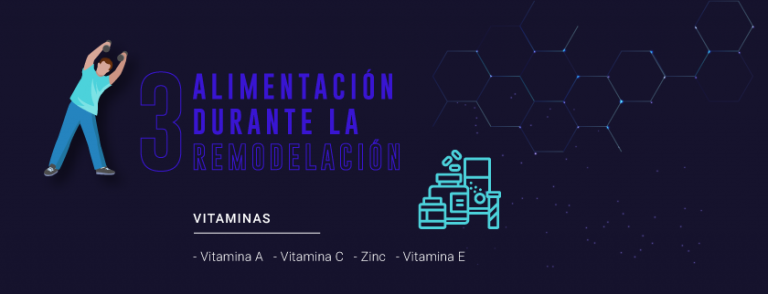
2. Nutrition during injuries: Rehabilitation phase
Adjust kcal without drastic reduction
When we are injured, nutrition has to adjust to your energy expenditure, but beware. A common mistake is the drastic restriction of calories when we injure ourselves, especially if it requires a period of immobilization. Sometimes it is not taken into account that the remodeling process consumes a lot of energy, between 15 and 40% of basal metabolism. If we excessively restrict calories during this process, we will delay and risk the healing of the injury.
Reduce carbohydrates, increase proteins
If we don’t train and barely move, we won’t need as much carbohydrates. We could reduce this macronutrient. But beware, if we combine an excessive cut in calories with an insufficient intake of protein, we will promote the loss of muscle mass. During the first weeks there are the greatest losses in both muscle mass and functionality. It is essential to keep this decrease in hypertrophy as small as possible. To do this, it would be advisable to increase the kcal we ingest each day (we may not increase them, but if we were on a hypocaloric or normocaloric diet we should do a slightly hypercaloric one). As you already know, nutrition during injuries is much more complex than all this and depends on each person, their objective and their circumstances.
Supplementation
An increase in the daily amount of protein to 2 g per kg of weight prevents the catabolism of muscle mass. If we do not arrive with our food, we can use supplementation without problem. Among the amino acids, the one that has a more anabolic character and is more important to avoid the loss of this mass is leucine . This is found in foods such as eggs, soy, dairy, peanuts, meat and fish.
In some studies it seems to be observed that supplementation with creatine helps to preserve muscle mass in periods of injury. If you want to know more about this supplement, take a look at our post: “Creatine. Now you know ”
If the injuries are abrasive, falls or burns, the protein and calorie requirements will also be increased. The more severe the burns, the greater the need for protein. Proteins are totally related to the immune system.
Calcium and vitamin D
When there is also a bone fracture, calcium and vitamin D become more important. Calcium is found in dairy products, sardines, almonds, chickpeas, broccoli and many other foods.
With 15 minutes of sun a day we produce the sufficient amount of vitamin D we need, but if sun exposure is not possible because it is contraindicated, we can also provide it with food, whole dairy products, Eggs and oily fish (salmon, tuna, sardines, anchovies, mackerel …) are rich in this nutrient.
Collagen, shark cartilage, hyaluronic acid …?
Sorry, but when you take collagen pill or liquid, it doesn’t go to your sore knee. The organism does not work like that. Collagen is a difficult to digest fibrous protein. It is made up of several interlocking chains of a few amino acids, none of them leucine. Collagen is useful to increase the total daily protein intake, but it is a low quality protein and, like all proteins, it needs to be “cut down” in amino acids in order to be absorbed, so it loses its nature and where they are to be used. Those amino acids will depend on other factors.
Antioxidants
During an injury, antioxidant nutrients naturally present in food promote recovery. These are mainly found in fruits and vegetables . We can also find large amounts of antioxidant substances in spices such as turmeric. Getting used to cooking with spices of this type is very interesting.
What about antioxidant supplements?
Nutrition when you are injured is very important, but all physiological processes take time and there are no magic formulas for now. The best antioxidant supplements can be found in food and in the enzymes that your body synthesizes to neutralize the free radicals that are generated during physical exercise, work stress, etc.
This production of free radicals and oxidative stress does not have a negative effect on health. A positive factor is that they generate metabolic adaptations that improve sports performance.
The human body is capable of converting reactive oxygen species to less toxic products, avoiding oxidative damage to cells. Some of the most important enzymes are superoxide dismutase, glutathione peroxidase, and catalase.
An athlete has a daily requirement of antioxidants higher than the general population, so their nutrition during injuries should include vegetable sources, fruits, citrus, legumes, nuts , cereals, seeds and oils.
Uncontrolled use of antioxidant supplements can create excess antioxidants and turn them into pro-oxidants, which act like free radicals. Therefore it is important that its use is under the recommendation of a professional.
As you have seen, having a correct, quality diet, sufficient in energy, protein and nutrients is essential to prevent such injuries, recover from them or minimize collateral effects.
Here are three recipes loaded with nutrients to enrich your nutrition during injuries:
Baked mackerel with potatoes, onion and parsley
Mackerel is a very interesting fish due to its high content of omega 3, being superior to that of salmon. Potatoes, being a tuber, in addition to carbohydrates contain soluble fibers that are very interesting for our gastrointestinal health, serving as food for our microbiota.
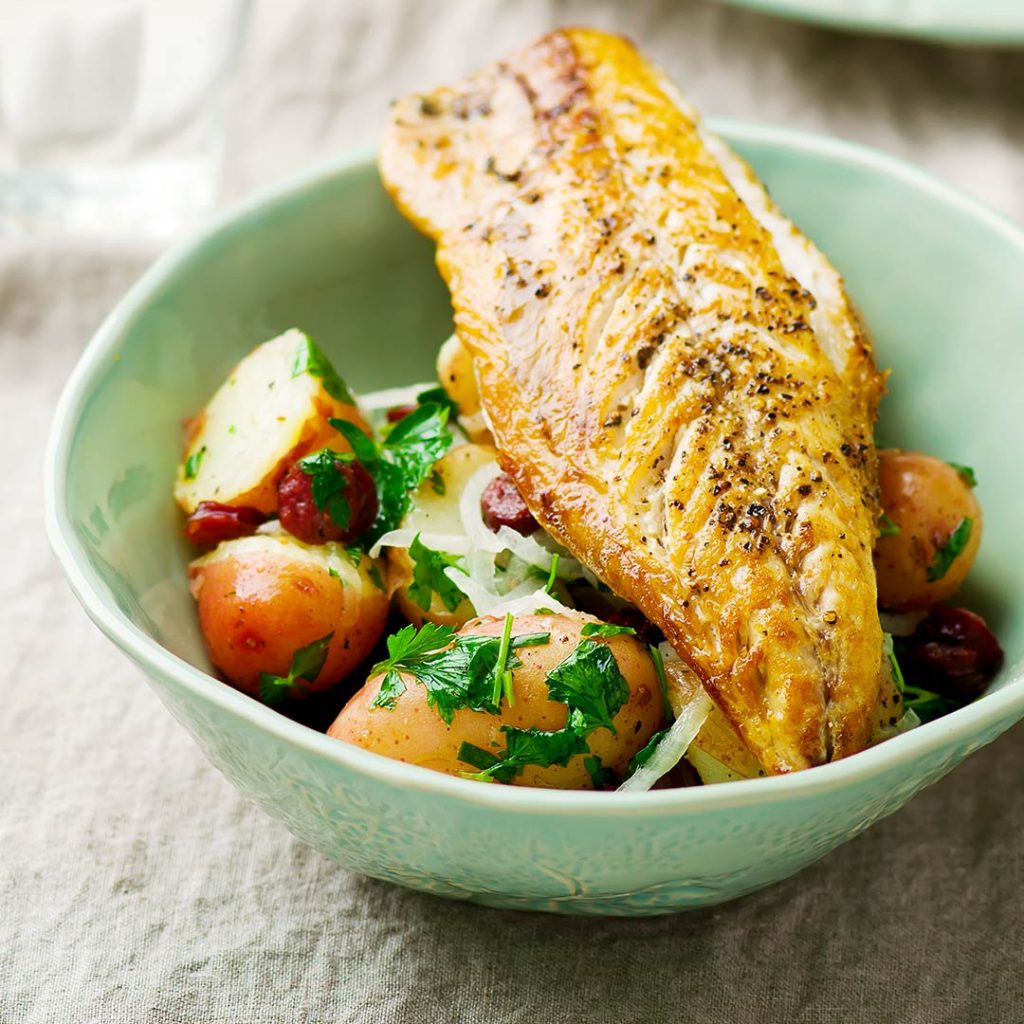
Ingredients
- Mackerel 120 g
- Parsley 3 g
- Olive oil 5 g
- Table salt 1 g
- Onion 50 g
- Black pepper 1 g
- Potato with skin 100 g
Elaboration
- Cleans the spiny mackerel, head and skin, leaving clean fillets.
- Clean the potatoes and cut them in half.
- Peel and cut the onion into julienne.
- Put the potatoes, onion, olive oil, a pinch of salt and chopped parsley on a baking sheet.
- Preheat in the oven to 180ºC and cook the tray for 15 minutes.
- Take out the tray and place the mackerel.
- Bake for 10-15 more minutes.
- Salt and pepper and plate everything together.
Indicators for a portion
Kcal: 363
Proteins: 28% | Hydrates: 25% | Fat: 47%
Cocoa cream with avocado, hazelnuts and coconut oil
This is a much healthier alternative while still being delicious to the popular commercial cocoa creams. It provides a wide variety of healthy fats, such as medium chain triglycerides, in addition to the antioxidant power of cocoa polyphenols.
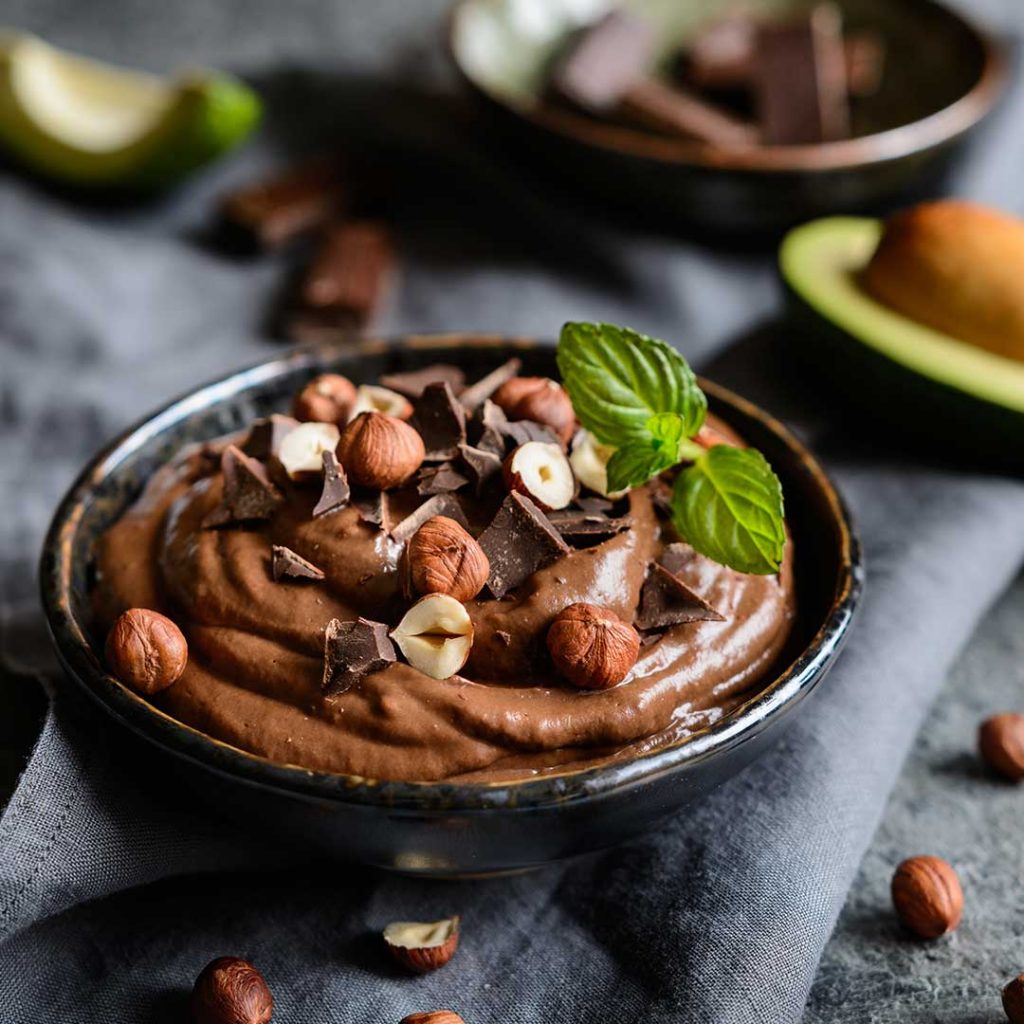
Ingredients
- C acao powder 30 g
- Avocado 70 g
- Olive oil 5 g
- Hazelnuts 40 g
- Liquid sweetener 3 g
- Dark chocolate 70-85% 5 g
Elaboration
- Chop the hazelnuts for a few minutes in the food processor until you get a creamy and homogeneous paste.
- Add the peeled avocado, cocoa powder, coconut oil and liquid sweetener to the chopper.
- Put it all in a serving bowl.
Indicators for a portion
Kcal: 587
Proteins: 7% | Hydrates: 27% | Fat: 66%
Lentil, lamb’s lettuce, strawberry and cottage cheese salad
Cottage cheese is a very interesting cheese since it combines a very pleasant flavor and texture together with a high protein content, it can be made from skimmed, semi-skimmed or whole milk, so we lets you play with it even more. If we combine it with lentils, vegetables and strawberries, we get a different and rich dish, also rich in nutrients, as well as being very satisfying.
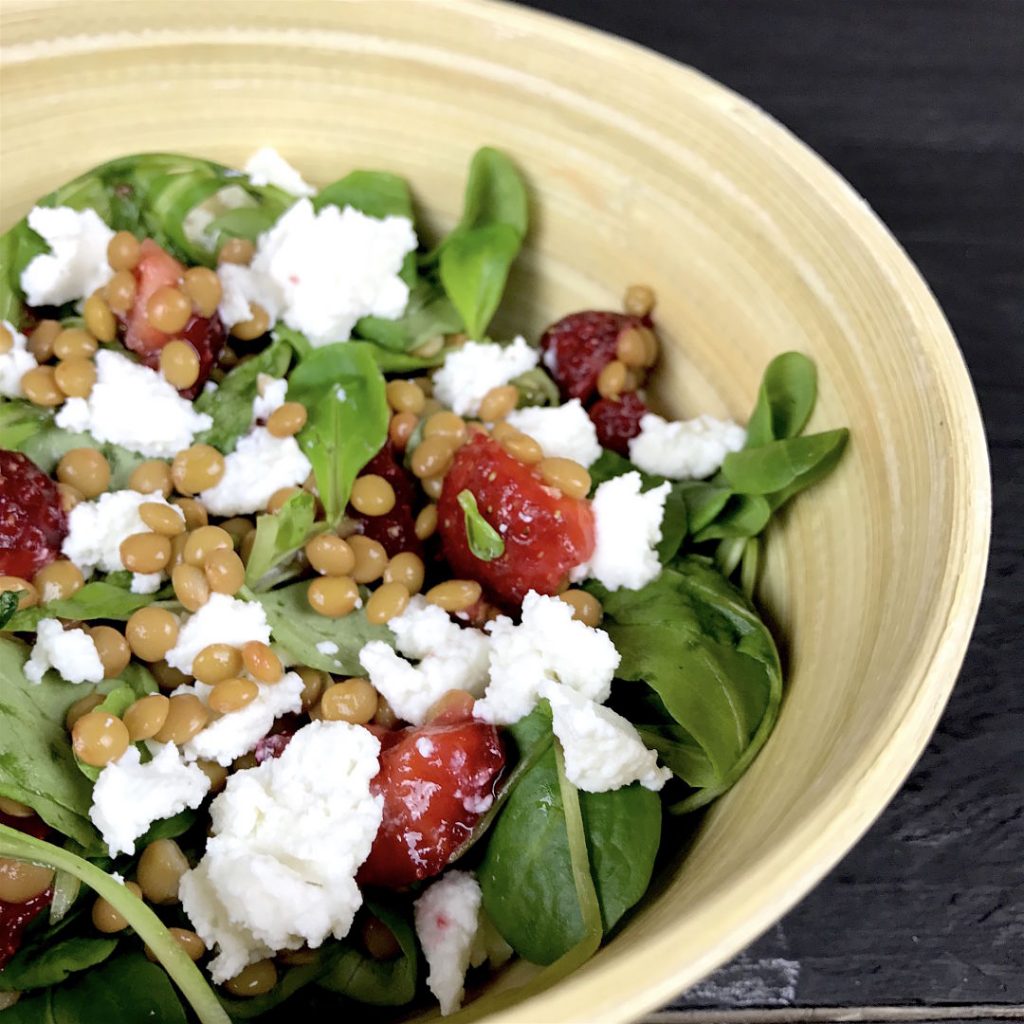
Ingredients
- Cooked lentils 150 g
- Strawberry 80 g
- Canons 40 g
- Vinegar of Modena 5 g
- Olive oil 5 g
- Table salt 1 g
- Cottage cheese 40 g
Preparation
- Drain the lentils well under running water and place in a bowl.
- Add to the bowl of the lentils, the chopped strawberries, the lamb’s lettuce, the cottage cheese.
- Prepare the vinaigrette by mixing well a tablespoon of oil, a tablespoon of vinegar and a pinch of salt.
- Add the chopped strawberries, lamb’s lettuce, cottage cheese to the bowl of lentils.
- Add the vinaigrette to the bowl, stir everything and it’s ready to eat.
Indicators for a portion
Kcal: 308
Proteins: 25% | Hydrates: 52% | Fat: 23%

